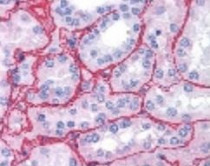ARG55536
anti-Collagen IV antibody
anti-Collagen IV antibody for IHC-Frozen sections,IHC-Formalin-fixed paraffin-embedded sections,Western blot and Human,Mouse,Rat,Mammal
Angiogenesis Study antibody; Basement Membrane Marker antibody
Overview
| Product Description | Rabbit Polyclonal antibody recognizes Collagen Type IV |
|---|---|
| Tested Reactivity | Hu, Ms, Rat, Mamm |
| Tested Application | IHC-Fr, IHC-P, WB |
| Specificity | Recognizes human Collagen Type IV. Typically less than 1% crossreactivity against other types of collagens was detected by ELISA against purified standards. Reacts with most mammalian Type IV collagens and has negligible crossreactivity with Type I, II, III, V or VI collagens. Non-specific crossreactivity with other human serum proteins or non-collagen extracellular matrix proteins is negligible. |
| Host | Rabbit |
| Clonality | Polyclonal |
| Isotype | IgG |
| Target Name | Collagen IV |
| Antigen Species | Human |
| Immunogen | Collagen Type IV from Human and Bovine placenta. |
| Conjugation | Un-conjugated |
| Alternate Names | BSVD; RATOR; Collagen alpha-1(IV) chain |
Application Instructions
| Application Suggestion |
|
||||||||
|---|---|---|---|---|---|---|---|---|---|
| Application Note | IHC-P: Antigen Retrieval: Boil tissue section in 0.01M Sodium citrate buffer (pH 6.0) for 20 min. * The dilutions indicate recommended starting dilutions and the optimal dilutions or concentrations should be determined by the scientist. |
Properties
| Form | Liquid |
|---|---|
| Purification | Affinity purification with immunogen. |
| Buffer | BBS (pH 8.0), 0.005M EDTA and 0.01% Sodium azide |
| Preservative | 0.01% Sodium azide |
| Stabilizer | 0.005M EDTA |
| Concentration | 1 mg/ml |
| Storage Instruction | For continuous use, store undiluted antibody at 2-8°C for up to a week. For long-term storage, aliquot and store at -20°C or below. Storage in frost free freezers is not recommended. Avoid repeated freeze/thaw cycles. Suggest spin the vial prior to opening. The antibody solution should be gently mixed before use. |
| Note | For laboratory research only, not for drug, diagnostic or other use. |
Bioinformation
| Database Links | |
|---|---|
| Gene Symbol | COL4A1 |
| Gene Full Name | collagen, type IV, alpha 1 |
| Background | Collagen IV proteins are integral components of basement membranes. This gene shares a bidirectional promoter with a paralogous gene on the opposite strand. The protein consists of an amino-terminal 7S domain, a triple-helix forming collagenous domain, and a carboxy-terminal non-collagenous domain. It functions as part of a heterotrimer and interacts with other extracellular matrix components such as perlecans, proteoglycans, and laminins. In addition, proteolytic cleavage of the non-collagenous carboxy-terminal domain results in a biologically active fragment known as arresten, which has anti-angiogenic and tumor suppressor properties. Mutations in this gene cause porencephaly, cerebrovascular disease, and renal and muscular defects. Alternative splicing results in multiple transcript variants. [provided by RefSeq, Dec 2014] |
| Function | Collagen IV is the major structural component of glomerular basement membranes (GBM), forming a 'chicken-wire' meshwork together with laminins, proteoglycans and entactin/nidogen. Arresten, comprising the C-terminal NC1 domain, inhibits angiogenesis and tumor formation. The C-terminal half is found to possess the anti-angiogenic activity. Specifically inhibits endothelial cell proliferation, migration and tube formation. Inhibits expression of hypoxia-inducible factor 1alpha and ERK1/2 and p38 MAPK activation. Ligand for alpha1/beta1 integrin. [UniProt] |
| Research Area | Angiogenesis Study antibody; Basement Membrane Marker antibody |
| Calculated MW | 161 kDa |
| PTM | Lysines at the third position of the tripeptide repeating unit (G-X-Y) are hydroxylated in all cases and bind carbohydrates. Prolines at the third position of the tripeptide repeating unit (G-X-Y) are hydroxylated in some or all of the chains. Type IV collagens contain numerous cysteine residues which are involved in inter- and intramolecular disulfide bonding. 12 of these, located in the NC1 domain, are conserved in all known type IV collagens. The trimeric structure of the NC1 domains is stabilized by covalent bonds between Lys and Met residues. Proteolytic processing produces the C-terminal NC1 peptide, arresten. |
Images (2) Click the Picture to Zoom In
-
ARG55536 anti-Collagen IV antibody IHC-P image
Immunohistochemistry: Formalin-fixed and paraffin-embedded Human kidney stained with ARG55536 anti-Collagen IV antibody at 1:400, 45 min at RT. Antigen Retrieval: Boil tissue section in 0.01M Sodium citrate buffer (pH 6.0) for 20 min.
-
ARG55536 anti-Collagen IV antibody IHC-P image
Immunohistochemistry: Formalin-fixed and paraffin-embedded Human liver stained with ARG55536 anti-Collagen IV antibody at 1:400, 45 min at RT. Antigen Retrieval: Boil tissue section in 0.01M Sodium citrate buffer (pH 6.0) for 20 min.







